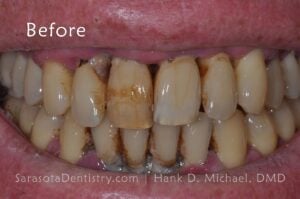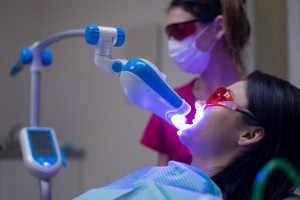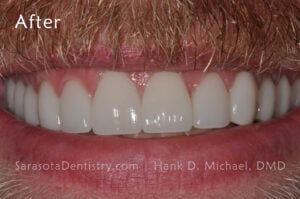
Brown spots on teeth can be prominent or barely noticeable and range from light yellow to dark brown. Some spots might not be spots at all but irregular or uniform lines. So, what causes brown spots on teeth? While brown spots often result from poor hygiene and pose an aesthetic concern, they could also be symptomatic of other health conditions, like celiac disease.
Table of Contents
Potential Causes of Brown Spots on Teeth
A person asking, “Why do I have brown spots on my teeth?” will find that this problem has several potential causes. One is the build-up of tartar, which consists of the plaque and other minerals that harden when brushing does not remove them. Tartar above the gum line leaves yellow, tan, or brown spots that can spread. When below the gums, tartar can look brown or black or cause gum recession and other dental problems.
Poor Oral Care
Poor oral care can result in tooth decay extensive enough to require a root canal. In some cases, the pulp, or connective tissue and nerves inside the tooth and root, can die, turning the tooth brown. Sometimes, damage to the nerves and roots and the resulting discoloration come from injury or trauma.
Staining Foods and Drinks

Dental Fluorosis
Sometimes in oral health care, there can be too much of a good thing, such as fluoride. Although it protects teeth, too much fluoride can lead to dental fluorosis, typically occurring in children whose baby teeth have yet to push through. Although fluorosis usually manifests in white markings, teeth can have pits and brown spots in rare, severe cases.
Aging and Health Conditions
Although many brown spots can be linked back to poor oral hygiene, some of them result from genetics or aging factors like darkening of the enamel. Also, medications like prescription mouthwash and some antibiotics can cause brown spots. Another cause not related to hygiene includes old dental work like metal fillings that cause brown spots and white fillings that accumulate stains over time.
Some health problems can create conditions that lead to brown spots on teeth. One such condition is enamel hypoplasia, resulting from malnutrition during pregnancy, vitamin deficiencies, or toxin exposure. Enamel hypoplasia can leave teeth with brown spots and a rough, pitted texture. Brown spots and other oral symptoms can also be a concern for people with celiac disease, an intolerance of food with gluten. People with celiac disease also have an increased risk for canker sores, dry mouth, and mouth ulcers.
Symptoms Associated with Brown Spots
Discoloration could be an early sign of a cavity that requires dental care. In addition to spots, a person might also experience gum bleeding, sensitivity, pain, or bad breath. An untreated cavity could result in gingivitis, which is a common form of gum disease. In any case, a patient should see a dentist as soon as possible if they notice brown spots on teeth near gums that bleed.
Treating Brown Spots on Teeth
A dentist can advise a patient on how to get rid of brown spots on teeth. Good at-home oral hygiene, including brushing twice and flossing once each day, is a good start. Smoking can cause brown spots over time, so it is best to avoid the habit or quit.
Teeth Whitening

Individuals might also consider over-the-counter whitening products, such as strips, toothpaste, or bleaching kits. Consumers should use products endorsed by the American Dental Association (ADA) and apply them regularly. However, they should avoid using whitening products too much because they could start to wear down the enamel.
People whose teeth do not respond well to at-home whitening methods should ask their dentist about professional whitening treatments. While they often require several appointments, professional whitening can remove brown spots on teeth effectively. Results can last a few years. The downside is that whitening only works on natural teeth and not on crowns or bonding.
Porcelain Veneers and Dental Bonding

A dentist can recommend other professional treatments for permanent or semi-permanent results. One type includes porcelain veneers, which are customized thin layers of ceramic that fit over front teeth. Not only do veneers cover up brown spots, but they can also correct teeth that are crooked, chipped, or have suffered decay.
Another professional solution to brown spots on teeth is cosmetic bonding, which involves fusing material to a tooth’s enamel to alter its shape and color. This process not only improves the look but also strengthens the tooth while helping it feel natural.
An alternative to traditional bonding and veneers is Bioclear, a treatment that restores teeth to their original, healthy look. During this process, the dentist wraps a thin sheet of mylar around the teeth and under the gum line to create a mold. Then, the dentist injects a liquid resin into the mold to generate a new surface. After hardening, the resin gets shaped to produce a natural, smooth look.
Prevention
Good oral hygiene will help keep teeth strong and healthy, as well as regular dental cleanings. Flossing daily and brushing at least twice a day will prevent many problems in the long run, including brown spots on teeth. Another excellent practice is to avoid smoking, which leaves unsightly stains on teeth.
Certain foods and beverages can leave stubborn brown spots over time. For instance, sugary treats like candy, desserts, and soda can cause tartar to build up. Other foods to avoid or consume minimally are white bread, potato chips, and other simple carbohydrates because they turn into sugars after consumption. Beverages like coffee and tea can also leave brown stains, but rinsing the mouth afterward can limit their impact on teeth.
Whenever eating sugars and carbs, a person should brush as soon as possible afterward. Foods that can enrich teeth include those with calcium, like cheese, milk, and yogurt. Calcium-based items can help prevent erosion of the enamel.
- Dental Implant Pros and Cons - August 26, 2023
- Receding Gums Stages - August 12, 2023
- When Is It Too Late for Gum Grafting? - July 8, 2023


